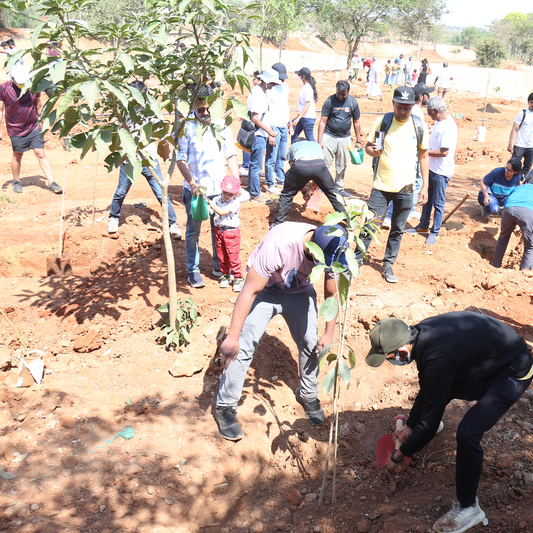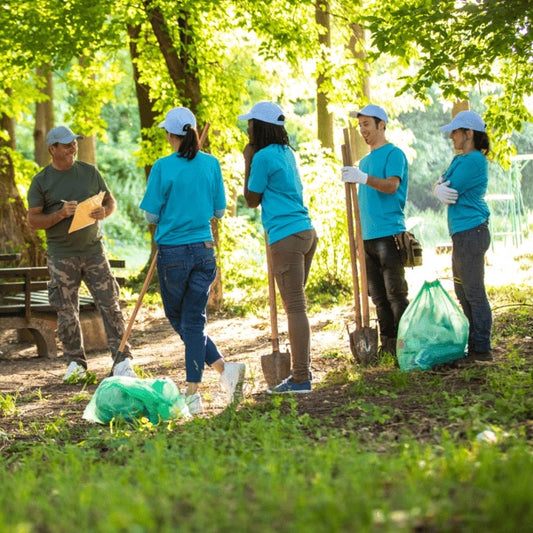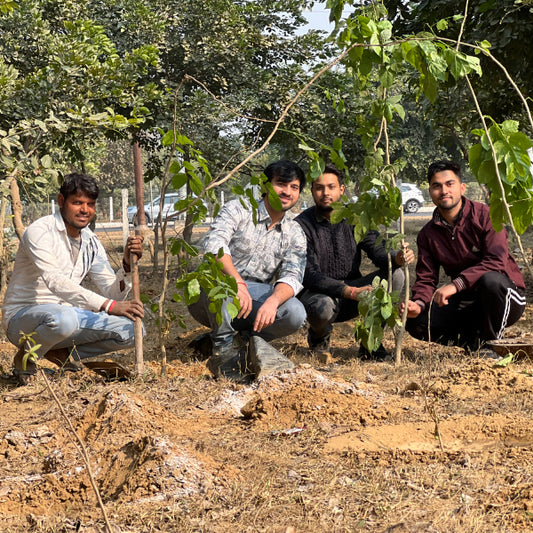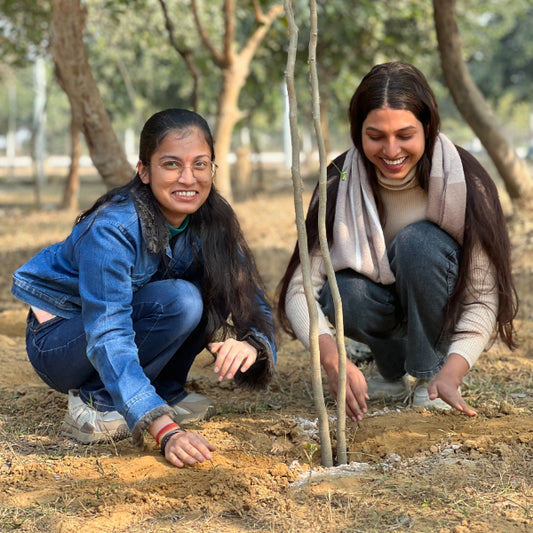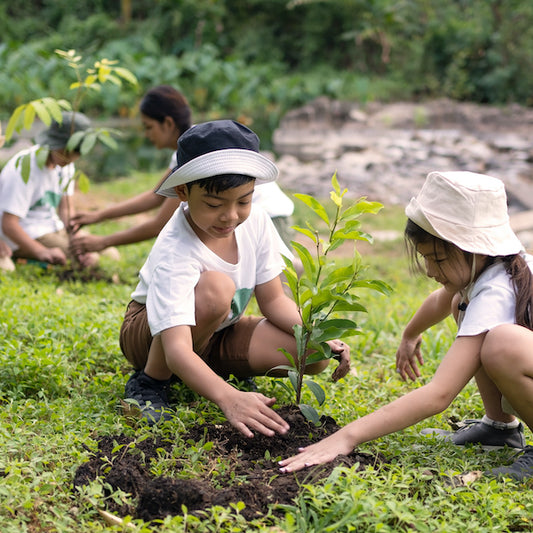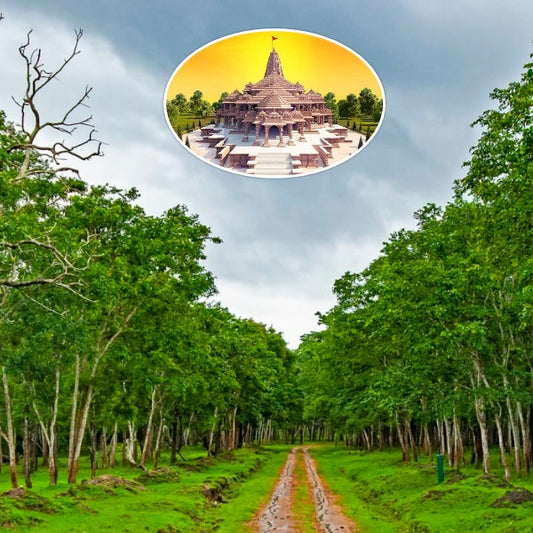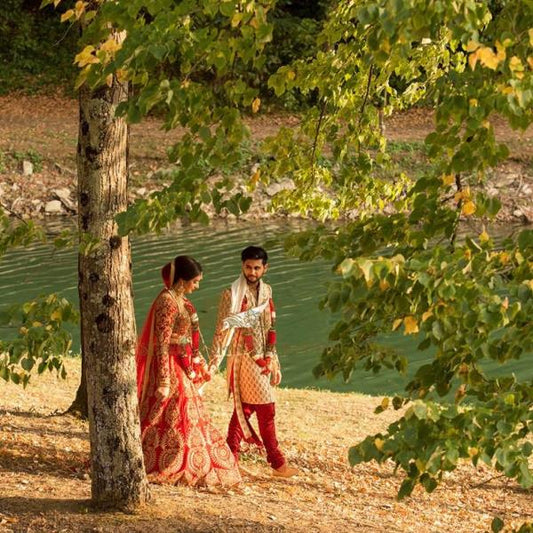Garima's Green Beginning: A Tree Plantation Celebration for a Sustainable Future
Garima's first birthday was celebrated in a truly meaningful and sustainable way through a tree plantation initiative in the agroforest concept, organ Read more
Plantation Site Gallery
Project Update 1





Digital Forest
Forest with 30 Trees planted
Top Trees Planted
Garima's Green Beginning: A Tree Plantation Celebration for a Sustainable Future
Garima's first birthday was celebrated in a truly meaningful and sustainable way through a tree plantation initiative in the agroforest concept, organized by her father, Abheeshek Jadhav, and their family. This heartfelt event aimed to honor Garima’s special day while contributing to environmental preservation. The family chose to plant trees in an agroforestry setting, where trees are integrated with agricultural practices, promoting both ecological balance and sustainable farming.
Together, we're not only celebrating Garima's first year but also sowing the seeds for a healthier planet and a brighter future. By integrating trees with crops, this agroforestry approach supports enhanced income diversification, offering farmers additional revenue through tree products. It also improves livelihood resilience, providing protection against market fluctuations, and helps reduce farming costs by improving soil fertility and water conservation. These benefits align with sustainable agricultural practices, ensuring the trees thrive in harmony with the environment, contributing to improved biodiversity, soil health, and climate resilience.
Happy 1st birthday, Garima! May your life be filled with love, laughter, and a deep connection to the natural world. This memorable celebration combined love for family, community, and the Earth, creating a lasting legacy for Garima's first birthday.
Tree Plantation Date
15th April 2024
Plantation Location
Sahayadri Van, Girvi, Satara, Maharashtra 415523
Trees Planted
Total Count: 30 Trees
Species Name: Mango, Guava, Chiku, Jackfruit, Coconut
Forest Type: Agroforest
Abheeshek Jadhav celebrated his daughter Garima's first birthday with a meaningful and eco-friendly tree plantation initiative in the agroforest concept. This thoughtful gesture combined the joy of celebrating her milestone with a commitment to environmental sustainability. The family planted trees in an agroforestry setting, where trees are integrated with agricultural practices, promoting ecological balance while benefiting farmers. Through this initiative, Abheeshek aimed to support enhanced income diversification for local farmers, improving their livelihood resilience and reducing farming costs by fostering healthier soil and better water management. This tree plantation not only symbolized Garima’s first year but also sowed the seeds for a healthier planet, ensuring that her future is tied to a thriving, sustainable environment.
Advantages Of Agroforest
Enhanced Income Diversification
The integration of trees with agricultural crops in the agroforest concept allows farmers to diversify their sources of income. In addition to traditional crop yields, they can harvest tree products like fruits, timber, and medicinal plants, providing a steady and diverse revenue stream. This diversification reduces dependency on a single crop, offering farmers a more stable financial future.Improved Livelihood Resilience
By promoting agroforestry, this initiative helps farmers build resilience against unpredictable weather patterns and market fluctuations. Trees act as a buffer, protecting crops from extreme weather conditions like droughts or floods, while offering alternative income opportunities during times when crops might not perform well. This resilience ensures that farmers can withstand adverse conditions and maintain a sustainable livelihood.Reduced Farming Costs
Agroforestry practices naturally improve soil fertility through the nitrogen-fixing properties of some trees, leading to a decrease in the need for costly chemical fertilizers. Additionally, trees help conserve water by improving soil structure and moisture retention, reducing the need for expensive irrigation systems. This lowers farming costs over time, allowing farmers to reinvest in their land and produce.Improved Soil Health and Fertility
Trees in agroforestry systems contribute to soil health by preventing erosion, enriching the soil with organic matter, and enhancing its nutrient content. Their root systems help bind the soil, preventing it from washing away during heavy rains, which is common in monoculture farming practices. This results in more fertile soil, promoting better crop yields over time.Biodiversity Enhancement
Agroforestry practices foster greater biodiversity by providing habitats for a variety of species, including birds, insects, and other wildlife. The combination of trees and crops in agroforestry creates a more balanced ecosystem, which improves pest control and supports pollination, benefiting both agricultural production and the environment.Climate Change Mitigation
Trees in agroforestry systems play a critical role in combating climate change by absorbing carbon dioxide from the atmosphere. Through photosynthesis, they sequester carbon, reducing greenhouse gas emissions. This initiative contributes to carbon footprint reduction and helps mitigate the effects of climate change, creating a sustainable environment for future generations.Sustainable Land Use
Agroforestry promotes sustainable land management practices by combining forestry and agriculture. It encourages the use of land in a way that improves productivity without depleting natural resources. This helps in maintaining a healthy balance between agricultural practices and environmental conservation, ensuring long-term sustainability.Community Empowerment and Education
Abheeshek Jadhav’s initiative serves as a model for others in the community, promoting the benefits of agroforestry. It encourages local farmers to adopt more sustainable practices, empowering them to take ownership of their land and resources while learning about environmentally friendly farming methods. This creates a ripple effect of positive change, fostering a sense of environmental stewardship within the community.
Activities During Tree Plantation
During Abheeshek Jadhav’s tree plantation initiative for his daughter Garima’s first birthday, all plantation activities were carried out by local farmers, reinforcing the agroforest concept. The initiative began with site preparation, where farmers carefully selected land to ensure optimal growth conditions for the trees. Native and fruit-bearing saplings were planted in alignment with existing crops to promote biodiversity and sustainable land use. Farmers dug planting pits, enriched the soil with organic compost, and ensured proper spacing to allow both trees and crops to thrive together. After planting, they watered the saplings and applied natural mulch to retain soil moisture and prevent weeds. This collaborative effort not only enhanced local ecosystems but also empowered farmers by providing them with valuable resources and knowledge for sustainable agroforestry practices.
Tree Plantation Purpose
SDGs Achieved Through Agroforestry
1. SDG 1: No Poverty
Agroforestry enhances farmers' income through diversified sources such as fruits, timber, and medicinal plants, reducing dependence on a single crop. This diversification minimizes the risk of financial instability caused by crop failure, ensuring a more secure livelihood for farmers and their families. By creating sustainable revenue streams, the initiative helps alleviate poverty in rural communities.2. SDG 2: Zero Hunger
Planting trees in agroforestry systems improves agricultural productivity and food security. Trees enrich the soil, enhance water retention, and protect crops from harsh weather conditions. This results in higher yields and a more reliable food supply. Additionally, fruit-bearing trees provide direct sources of nutrition, contributing to healthier diets for farming families and surrounding communities.3. SDG 8: Decent Work and Economic Growth
Agroforestry practices create employment opportunities for local farmers, from planting to maintenance. The initiative encourages sustainable agricultural practices that lead to long-term economic growth in rural areas. By fostering skills in agroforestry, farmers can explore new markets for tree-based products, boosting economic resilience and local entrepreneurship.4. SDG 12: Responsible Consumption and Production
Agroforestry promotes the responsible use of land and natural resources. By integrating trees with crops, the initiative encourages sustainable farming that minimizes waste, reduces the need for chemical fertilizers, and prevents land degradation. This sustainable approach ensures that resources are utilized efficiently, supporting long-term agricultural productivity.5. SDG 13: Climate Action
Trees planted in agroforestry systems sequester carbon dioxide, playing a significant role in mitigating climate change. The initiative reduces greenhouse gas emissions by promoting carbon capture and preventing deforestation. Additionally, agroforestry improves the resilience of farming systems to extreme weather events, protecting crops and livelihoods from climate-related risks.6. SDG 15: Life on Land
The initiative enhances biodiversity by creating habitats for various species and protecting ecosystems. Agroforestry helps prevent soil erosion, improves soil fertility, and restores degraded land. This contributes to healthier ecosystems and promotes the conservation of terrestrial biodiversity, ensuring the sustainability of local environments.7. SDG 17: Partnerships for the Goals
Abheeshek Jadhav’s partnership with Grow Billion Trees has been instrumental in achieving SDG 17: Partnerships for the Goals by fostering collaboration between communities, farmers, and environmental organizations. Through this alliance, Abheeshek’s tree plantation initiative for his daughter Garima’s first birthday not only promoted agroforestry but also empowered local farmers by providing resources, saplings, and technical guidance. Grow Billion Trees facilitated seamless coordination, ensuring sustainable land use practices and maximizing the environmental impact of the plantation. This partnership exemplifies how collective efforts can drive meaningful progress, aligning with global sustainability goals and creating a lasting positive impact on local ecosystems and livelihoods.
ESGs Achieved Through Agroforestry
Environmental (E)
The agroforest tree plantation directly enhances environmental sustainability by promoting biodiversity, improving soil health, and combating climate change. By integrating trees with agricultural crops, the initiative reduces soil erosion, enriches soil fertility, and increases carbon sequestration, contributing to lower greenhouse gas emissions. The planted trees provide shade, reduce water evaporation, and enhance local ecosystems, fostering a balanced and resilient environment. This approach supports sustainable land use by minimizing deforestation and preserving natural habitats, creating a greener and more ecologically stable future.Social (S)
On the social front, the initiative uplifts local communities by empowering farmers and creating economic opportunities. By involving farmers in all plantation activities, Abheeshek’s project promotes livelihood resilience and income diversification, helping farmers generate revenue from tree-based products such as fruits, timber, and medicinal plants. This not only enhances their financial stability but also ensures food security through sustainable agricultural practices. The project also fosters community engagement and environmental awareness, encouraging collective responsibility for sustainable development.Governance (G)
From a governance perspective, Abheeshek Jadhav’s partnership with Grow Billion Trees exemplifies ethical leadership, transparency, and commitment to sustainability. The initiative aligns with broader SDG 17: Partnerships for the Goals, reflecting the importance of collaborative governance in addressing environmental challenges. By prioritizing sustainable practices and community involvement, the project sets a precedent for responsible governance and promotes long-term stewardship of natural resources. This initiative highlights the value of integrating environmental and social considerations into governance frameworks, ensuring alignment with global sustainability standards.
Commitment by Grow Billion Trees
Grow Billion Trees is committed to driving sustainable plantation efforts, ensuring every initiative aligns with key environmental objectives and promotes long-term ecological balance. They focus on selecting native tree species that are well-adapted to local ecosystems, ensuring a higher survival rate and stronger environmental impact.
To maintain plant health and longevity, Grow Billion Trees emphasizes continuous maintenance and regular monitoring of the plantations. This approach helps ensure that each tree thrives, contributing effectively to both biodiversity and climate resilience.
Transparency is a core principle in their operations. Clients receive comprehensive reports, including geo-tagging of planted trees, survival rate updates, and ongoing progress reports. This level of openness allows clients to track the direct impact of their contributions, reinforcing trust and accountability.
Through their dedication to sustainable practices, Grow Billion Trees ensures that every plantation project leaves a lasting positive footprint on both the environment and the local communities it serves.
Summary
Abheeshek Jadhav’s tree plantation initiative in honor of his daughter Garima’s first birthday embodies sustainability, community empowerment, and environmental responsibility. By adopting the agroforest concept, the initiative promotes biodiversity, enhances soil health, and supports local farmers through income diversification and livelihood resilience. All plantation activities were conducted by farmers, ensuring direct community involvement and fostering sustainable agricultural practices. Partnering with Grow Billion Trees, Abheeshek’s project contributes to key ESG goals and aligns with multiple UN SDGs, including climate action, poverty reduction, and responsible land use. This initiative not only celebrates a personal milestone but also sows the seeds for a greener, more sustainable future.
Trees for Corporates
Trending
Most Popular
FAQ
What is agroforest tree plantation and how does it benefit individuals?
Agroforest tree plantation blends agriculture with forestry, allowing crops and trees to coexist on the same land. For individuals, this approach enhances soil health, boosts biodiversity, and supports carbon sequestration. It’s a sustainable way to contribute to the environment while creating long-term benefits for farmers. Planting trees in agroforests also serves as a meaningful way to celebrate personal milestones, giving back to nature while supporting local communities.
Can individuals participate in agroforest tree planting initiatives?
Yes! Agroforest tree planting isn’t just for large corporations – individuals can actively contribute by planting trees for birthdays, anniversaries, or as part of personal carbon offset efforts. Many organizations offer programs where individuals can sponsor or plant trees in agroforests, ensuring sustainable growth while benefiting local farmers. It’s a simple yet impactful way to make a difference.
How does tree plantation in agroforests help farmers?
Tree plantations in agroforests provide farmers with multiple income streams, improving financial stability. Trees offer fruits, timber, and medicinal products, reducing farming costs and enhancing land productivity. This system boosts soil fertility, prevents erosion, and shields crops, ensuring better yields. By supporting agroforestry, individuals indirectly uplift farming communities, fostering long-term economic resilience.
Is agroforestry effective in fighting climate change?
Absolutely! Agroforestry plays a crucial role in mitigating climate change by sequestering carbon dioxide, enriching the soil, and preventing deforestation. Trees absorb CO2, reducing greenhouse gases while restoring degraded land. Individuals participating in agroforest plantations contribute to a greener planet, offsetting their carbon footprint and promoting environmental sustainability.
What types of trees are planted in agroforests?
Agroforests feature a mix of fruit-bearing, medicinal, and timber-producing trees, enhancing biodiversity. Popular choices include mango, neem, teak, and moringa. The selection depends on the land and local climate. By planting diverse tree species, individuals help create balanced ecosystems that support wildlife, boost farm productivity, and ensure long-term sustainability.
How can tree plantation celebrate personal milestones?
Tree planting for birthdays, anniversaries, and other milestones is a growing trend. By planting a tree in an agroforest, individuals create lasting memories while giving back to nature. Each tree symbolizes growth and sustainability, serving as a living tribute that matures over time, leaving behind a legacy for future generations.
Can tree plantations be gifted to others?
Yes! Gifting trees is a unique and eco-friendly way to celebrate special occasions. Individuals can plant trees in agroforests on behalf of loved ones, offering a meaningful gift that contributes to environmental conservation. It’s a gift that grows, providing benefits for years to come.
How does tree plantation impact soil health?
Trees in agroforests enhance soil quality by reducing erosion, replenishing nutrients, and improving water retention. Their roots prevent land degradation and promote healthier crops. Individuals who support agroforestry contribute to healthier ecosystems, ensuring sustainable farming practices and improved land productivity.
What role do individuals play in sustainable tree planting?
Individuals drive sustainability by participating in tree planting initiatives and promoting agroforestry practices. By planting trees, supporting farmer-led projects, and spreading awareness, individuals play a vital role in restoring the environment. Their contributions help combat deforestation and foster greener, more resilient landscapes.
How can I start my own agroforest tree plantation?
Starting an agroforest plantation involves selecting the right land, choosing diverse tree species, and ensuring proper maintenance. Many organizations provide saplings, technical guidance, and land preparation support. Individuals can begin by collaborating with environmental groups, joining agroforestry programs, or planting trees in their communities to promote sustainable growth.
1. Agroforest Birthday Tree Plantation
Why gift toys when you can gift a tree? Agroforest birthday tree plantations are the trendiest way to celebrate milestones. For individuals like Abheeshek Jadhav, planting trees for his daughter Garima’s birthday means growing memories that literally bloom over the years. Imagine a birthday gift that fights climate change, boosts farmers' incomes, and nourishes the land! Agroforests thrive by pairing crops with trees, benefiting biodiversity and ensuring land sustainability. The best part? You’re not just throwing a party – you’re throwing shade… the good kind! This green gift creates a legacy that stands tall, grows strong, and whispers stories of a brighter future.
2. Family Tree Plantation for Agroforests
Move over, photo albums – family trees are getting real! A family tree plantation in an agroforest isn’t just a metaphor, it’s a living legacy. Imagine generations of trees representing each milestone, sprouting leaves as your family grows. Individuals are now celebrating anniversaries and personal events by planting trees that blend with farmlands, boosting biodiversity and providing sustainable incomes for farmers. Plus, nothing says “family bond” like nurturing saplings together. Each tree stands as a green guardian of memories, rooted deep in love and sustainability.
3. Individual Agroforestry Projects
Who says agroforestry is just for large farms? Individuals are digging into agroforestry projects, planting trees alongside crops to enhance sustainability. Whether it’s a backyard mini-orchard or a community plot, planting fruit trees next to veggies boosts biodiversity and gives landowners the double benefit of fresh produce and climate resilience. It’s like farming but with an eco-friendly twist and a side of personal fulfillment. Small steps lead to mighty forests, and your little project could be the spark that inspires an entire community to green up their space!
4. Tree Plantation for Personal Milestones
Forget diamonds – trees are forever. Planting trees for personal milestones is the freshest way to mark achievements. Whether it’s your first marathon, graduation, or even a new job, a tree in an agroforest serves as a constant reminder of growth and success. Each sapling symbolizes progress, deeply rooted in sustainability. Plus, it’s the kind of gift that just keeps giving – carbon offsets, improved soil, and a greener planet! Who needs a trophy when you can have an entire forest in your honor?
5. Agroforest Tree Plantation as Gifts
Why wrap presents in paper when you can wrap the planet in greenery? Tree plantations as gifts are the future of meaningful presents. Whether for birthdays, weddings, or “just because,” gifting an agroforest tree means giving life. Individuals are increasingly choosing this option to celebrate loved ones while making the world a better place. Plus, trees don’t end up in landfills – they grow taller every year! Imagine the joy of telling someone, “I got you a tree!” and watching their face light up like a forest at dawn.
6. Personal Carbon Offset Tree Planting
Feeling guilty about that weekend road trip? Don’t worry – plant a tree and call it even! Personal carbon offset through agroforest tree planting allows individuals to balance their carbon footprint while enhancing farmland. Agroforestry trees sequester carbon, improve soil, and provide fruit or timber, making them a win-win for the planet and farmers. Each tree planted helps shrink your carbon guilt and grows your green karma. It's the easiest (and most stylish) way to be an eco-warrior without trading in your favorite car.
7. Agroforest Tree Planting for Celebrations
Celebrations are great, but celebrating with trees? Now that’s iconic. Birthdays, weddings, and even festivals are becoming greener thanks to agroforest tree planting initiatives. Individuals are turning their happiest moments into long-lasting legacies, giving back to nature while honoring life’s milestones. Planting trees for celebrations creates sustainable memories that outlive any party decoration. Why settle for confetti when you can sprinkle seeds of sustainability instead?
8. Commemorative Agroforestry Tree Planting
Some memories deserve roots – literally. Commemorative tree planting in agroforestry settings lets individuals honor lost loved ones or special events with a gift that grows forever. It’s a timeless tribute that nourishes the land, provides shelter for wildlife, and supports local farmers. Agroforestry ensures these trees coexist with crops, enhancing biodiversity and creating sustainable ecosystems. When words aren’t enough, let a tree stand in silent remembrance, growing stronger year after year.
- Choosing a selection results in a full page refresh.
- Opens in a new window.


